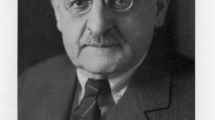Abstract
In the 17th century an Ottoman traveler, Evliya Celebi, was inspired by a dream to embark on a journey across the Ottoman Empire. He traveled far and wide across Europe and North Africa and wrote extensively about his adventures in the Seyahatname. The Seyahatname, or “Book of Travels,” is the longest and most detailed travel account in Islamic (if not world) literature. It is a vast panorama of the Ottoman world in the mid-17th century. This article is concerned with Celebi’s description of several surgeries that he claimed to have witnessed in Vienna during the year 1665. He describes several procedures, the first and most detailed of which is a fascinating brain operation that seems to be a highly unusual procedure for the time. His impressions of Central European medicine, as viewed by a Muslim from the East, offer an unexplored perspective. We examine what his description tells us about the perceptions and images of surgery and medicine.

Similar content being viewed by others
References
Kreiser K, Evliya C (2003) In: Kafadar C, Karateke H, Fleischer C (eds) Historians of the Ottoman Empire. http://www.ottomanhistorians.com/database/html/evliya_en.html. Accessed 11 Aug 2011
Dagli Y, Kahraman SA, Dankoff R (2003) Evliya Celebi Seyahatnamesi. 7. Kitap. Yapi Kredi Yayinlari, Istanbul, pp 108–110
Dankoff R, Kim S (2010) An Ottoman traveler: selections from the book of travels of Evliya Celebi. Eland, London, pp 219–249
Livingston JW (1970) Evliya Celebi on surgical operations in Vienna. Al-Abhath 23:225–240
Lyons AS, Keiner M (1987) Seventeenth century. In: Lyons AS, Petrucelli RJ (eds) Medicine: an illustrated history. Abradale Press/Abrams, New York, pp 427–463
Lybyer AH (1917) The travels of Evliya Effendi. J Am Oriental Soc 37:224–239
Rutkow IM (2008) The origins of modern surgery: the seventeenth century. In: Norton JA, Barie PS, Bollinger RR et al (eds) Surgery: basic science and clinical evidence. Springer, New York, pp 8–10
Mossensohn MS (2008) An Ottoman observer of Central European surgery in the middle of the seventeenth century. Vesalius 1:4–7
Terzioglu A (1975) Evliya Celebi’s Beschreibung der sudosteuropaischen Hospitaler und Heilbader des 17. Jahrhunderts und ihre kulturgeschichtliche Bedeutung. Rev Etud Sud Est Eur 13:431
Castigliono A (1958) A history of medicine. Alfred A. Knopf, New York, p 174
Wilkins RH (1997) Neurosurgical techniques: an overview. In: Greenblatt SH (ed) A history of neurosurgery in its scientific and professional contexts. American Association of Neurological Surgeons, Rolling Meadows, pp 193–198
Graham H (1939) The story of surgery. Doran, New York, pp 166–169
Thompson CJS (1942) The history and evaluation of surgical instruments. Schuman’s, New York, pp 35–45, 60–61
Castigliono A (1958) A history of medicine. Alfred A. Knopf, New York, p 483
Gudger EW (1925) Stitching of wounds with the mandibles of ants and beetles. JAMA 84:1861–1865
Bankoff G (1947) The story of surgery. Arthur Barker, London, p 21
Acknowledgments
I thank the following libraries and archives for allowing me to consult their manuscripts: Topkapi Palace Museum Library, Suleymaniye Library, Istanbul University Library.
Author information
Authors and Affiliations
Corresponding author
Rights and permissions
About this article
Cite this article
Bilsel, Y. Evliya Celebi’s Description of the Removal of a Musket Ball From the Brain of a Habsburg Prince: An Interesting Excerpt From the “Seyahatname”. World J Surg 36, 923–927 (2012). https://doi.org/10.1007/s00268-012-1434-2
Published:
Issue Date:
DOI: https://doi.org/10.1007/s00268-012-1434-2




